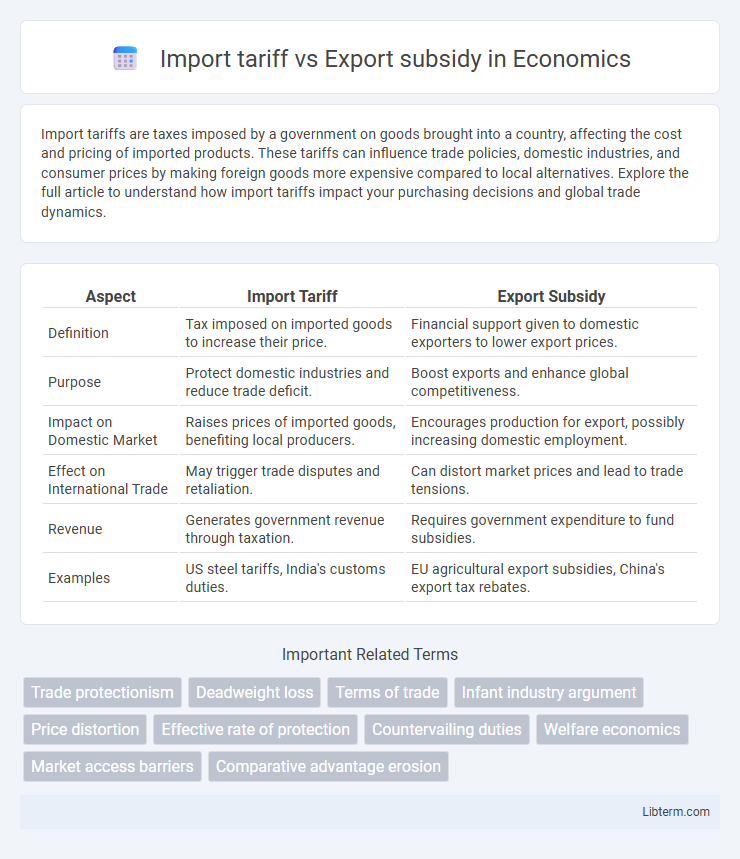Import tariffs are taxes imposed by a government on goods brought into a country, affecting the cost and pricing of imported products. These tariffs can influence trade policies, domestic industries, and consumer prices by making foreign goods more expensive compared to local alternatives. Explore the full article to understand how import tariffs impact your purchasing decisions and global trade dynamics.
Table of Comparison
| Aspect | Import Tariff | Export Subsidy |
|---|---|---|
| Definition | Tax imposed on imported goods to increase their price. | Financial support given to domestic exporters to lower export prices. |
| Purpose | Protect domestic industries and reduce trade deficit. | Boost exports and enhance global competitiveness. |
| Impact on Domestic Market | Raises prices of imported goods, benefiting local producers. | Encourages production for export, possibly increasing domestic employment. |
| Effect on International Trade | May trigger trade disputes and retaliation. | Can distort market prices and lead to trade tensions. |
| Revenue | Generates government revenue through taxation. | Requires government expenditure to fund subsidies. |
| Examples | US steel tariffs, India's customs duties. | EU agricultural export subsidies, China's export tax rebates. |
Understanding Import Tariffs: Definition and Purpose
Import tariffs are taxes imposed by a government on goods brought into a country, designed to increase the cost of foreign products and protect domestic industries from international competition. These tariffs generate revenue for the government while encouraging consumers to buy domestically produced goods. By understanding import tariffs, businesses and policymakers can evaluate their impact on trade balances, consumer prices, and economic growth.
What Are Export Subsidies? Key Characteristics
Export subsidies are government financial supports provided to domestic producers to encourage the export of goods and services, enhancing their competitiveness in international markets. Key characteristics include direct payments, tax relief, or reduced export duties, which lower production costs and increase profit margins for exporters. These subsidies aim to boost export volumes, improve trade balance, and support strategic industries, but they may lead to trade distortions and retaliatory tariffs in global commerce.
Economic Objectives of Import Tariffs
Import tariffs aim to protect domestic industries by increasing the cost of imported goods, thereby encouraging consumers to buy locally produced products and supporting job retention within the country. They generate government revenue, which can be used to fund public services and infrastructure, contributing to overall economic stability and growth. Such tariffs help reduce trade deficits by limiting imports and potentially improving the country's balance of payments.
Why Governments Implement Export Subsidies
Governments implement export subsidies to enhance the competitiveness of domestic industries in the global market by lowering production costs and reducing export prices. These financial supports stimulate economic growth, increase foreign exchange earnings, and create employment opportunities. Export subsidies serve as strategic tools to counteract import tariffs imposed by other countries, promoting national trade balance and market expansion.
Comparative Impact on Domestic Industries
Import tariffs increase the cost of foreign goods, encouraging consumers to buy domestically produced products and providing protection for local industries against international competition. Export subsidies lower the cost of domestic goods in foreign markets, boosting the competitiveness and market share of domestic industries abroad while potentially leading to trade disputes. The comparative impact on domestic industries depends on the goal: tariffs shield local producers from imports, whereas subsidies promote export growth and global expansion.
Effects on International Trade Balance
Import tariffs increase the cost of imported goods, reducing import volume and improving a country's trade balance by decreasing trade deficits. Export subsidies lower production costs for exporters, boosting export volume and potentially leading to trade surpluses by increasing foreign sales. Both policies distort international trade flows and can provoke retaliatory measures, affecting global market equilibrium.
Consumer and Producer Implications
Import tariffs raise consumer prices by increasing the cost of foreign goods, leading to reduced consumer surplus and potential welfare loss, while benefiting domestic producers by providing protection from foreign competition and potentially increasing their market share. Export subsidies lower the cost of domestic goods in foreign markets, enhancing producer revenues and competitiveness abroad, but can lead to higher domestic prices and reduce consumer welfare by diverting goods from local markets to exports. Both policies distort market efficiency, impacting resource allocation and potentially provoking retaliatory trade measures.
WTO Rules: Legal Perspectives on Tariffs and Subsidies
Import tariffs and export subsidies are key trade policy tools regulated under World Trade Organization (WTO) rules to maintain fair competition and minimize trade distortions. WTO agreements, such as the Agreement on Subsidies and Countervailing Measures (SCM Agreement) and the General Agreement on Tariffs and Trade (GATT), impose strict conditions on tariffs and prohibit certain export subsidies that confer unfair advantages. Legal disputes often arise from alleged breaches of these rules, with panels assessing whether measures violate tariff bindings or result in prohibited subsidies under WTO jurisprudence.
Case Studies: Countries Using Tariffs vs Subsidies
China's use of import tariffs on steel and aluminum safeguards domestic industries while promoting local production, contrasting with the European Union's export subsidies in agriculture that enhance global competitiveness but trigger trade disputes. India employs import tariffs to protect its electronics sector, whereas Brazil utilizes export subsidies to support its biofuel industry, boosting exports to international markets. These approaches reflect strategic economic policies tailored to national priorities, influencing global trade dynamics and market access.
Policy Effectiveness: Which Tool Works Best?
Import tariffs protect domestic industries by increasing foreign goods' prices, effectively reducing imports and boosting local production, but may lead to trade disputes and higher consumer costs. Export subsidies enhance competitiveness of domestic products in international markets by lowering costs for exporters, potentially increasing export volumes but risking retaliation and market distortions. Policy effectiveness depends on economic priorities, with tariffs favoring domestic market protection while subsidies target export growth and global market share.
Import tariff Infographic

 libterm.com
libterm.com